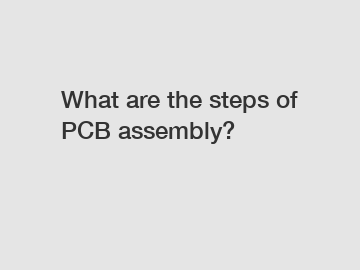What are the steps of PCB assembly?
What are the steps of PCB assembly?
Printed Circuit Boards (PCBs) are an integral part of electronic devices, and their assembly is a critical process in the manufacturing industry. PCB assembly involves various steps that transform a bare board into a functional electronic circuit. Let's explore the essential stages involved in PCB assembly.
Component Sourcing and Procurement.

The first step in PCB assembly is sourcing and procuring the necessary components. This involves selecting and acquiring all the required electronic components, such as resistors, capacitors, integrated circuits, connectors, and more. Manufacturers often work closely with suppliers to ensure they obtain high-quality components for the assembly process.
Solder Paste Application.
Next, solder paste is applied to the bare PCB. Solder paste is a mixture of solder alloy and flux, which helps create secure electrical connections on the board. Automated stencil printers are usually employed to accurately apply the solder paste to specific areas of the PCB. The stencil holds openings for the solder paste, ensuring precise deposition.
Component Placement.
Once the solder paste is applied, the components are placed on the board. Advanced pick-and-place machines are used to precisely position each component on its designated place on the PCB. The machines use vision systems to ensure accurate alignment and placement. Proper component placement is crucial for achieving reliable and effective circuit functionality.
Reflow Soldering.
After component placement, the PCB undergoes reflow soldering. In this process, the PCB is exposed to a controlled temperature environment using a reflow oven or conveyor system. The temperature is carefully managed to melt the solder paste, causing it to bond the components and the PCB together. The PCB then moves through a cooling zone, solidifying the solder joints.
Inspection and Quality Control.
Once the PCB has been through reflow soldering, it undergoes rigorous inspection and quality control procedures. Automated optical inspection (AOI) machines are used to examine the board for any potential defects, such as misplaced components, solder bridges, or solder joint quality. Manual inspections are also performed to ensure the board meets industry standards and customer requirements.
Testing.
After passing the inspection, the PCB moves to the testing phase. Testing is crucial to identify any manufacturing defects or functional issues. Different testing methods, such as in-circuit testing (ICT), functional testing, and boundary scan testing, are employed to ensure the circuit's integrity and functionality. Thorough testing helps prevent faulty PCBs from reaching the market and ensures optimal performance.
Cleaning and Coating.
Once the PCB has been tested, it undergoes cleaning and coating processes. Cleaning aims to remove any residues or flux left on the board after soldering. Ultrasonic cleaning machines and specific solvents are used to clean the PCB thoroughly. Coating, on the other hand, involves applying a protective layer, such as conformal coating, to shield the PCB from environmental factors and enhance its durability.
Final Inspection and Packaging.
After cleaning and coating, the PCB goes through a final inspection to ensure it is free from any contamination or defects. Once approved, the PCB is ready for packaging. Proper packaging helps protect the PCB during transportation and safeguards it against physical damage or contamination.
In conclusion, the PCB assembly process involves several vital steps to transform a bare board into a fully functional electronic circuit. Component sourcing, solder paste application, component placement, reflow soldering, inspection, testing, cleaning, coating, and final inspection are the key stages involved in PCB assembly. Adhering to stringent quality control measures throughout these steps is essential to ensuring high-quality and reliable PCBs.
If you have any further questions about PCB assembly or need assistance with your electronic manufacturing needs, please don't hesitate to contact us.
For more information, please visit security electronics pcb assembly, portable power supply pcba, security pcb assembly.



Comments
0